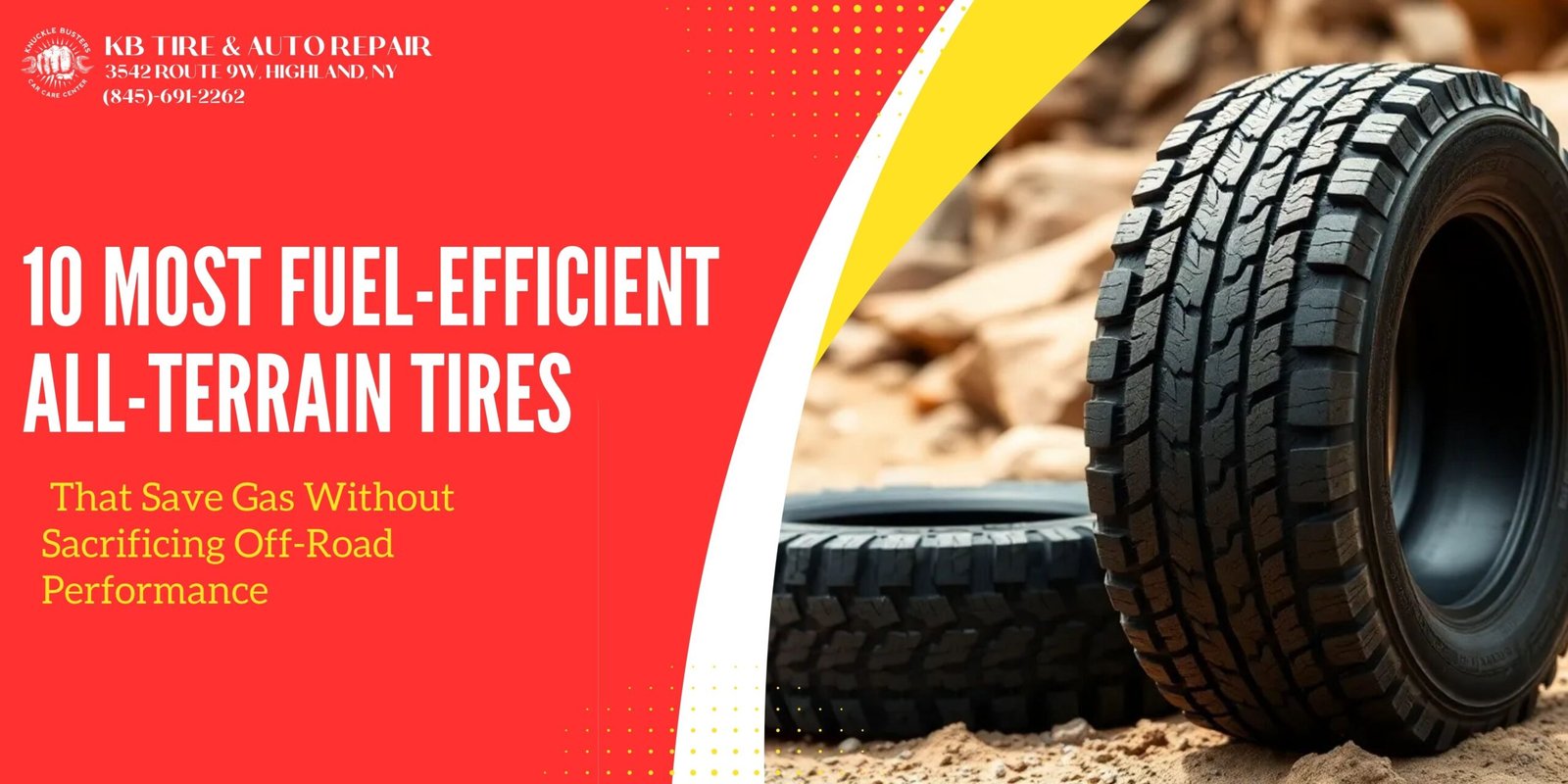Want to tackle rough terrain without watching your fuel gauge plummet? You’re not alone. Today’s drivers demand all-terrain tires that deliver impressive off-road performance without sacrificing fuel economy. As gas prices continue to fluctuate, finding the perfect balance has never been more important.
The right all-terrain tires can save you hundreds of dollars annually at the pump while still providing the durability and traction you need for adventures beyond the pavement. Many manufacturers now engineer tires specifically designed to reduce rolling resistance—the key factor in fuel efficiency—without compromising the aggressive tread patterns and sturdy construction that define all-terrain performance.
Understanding the Impact of Tires on Fuel Efficiency
Your tire choice significantly affects your vehicle’s fuel consumption—a fact many drivers overlook when seeking better gas mileage.
How Tire Design Affects Gas Mileage
Tire design plays a crucial role in determining your vehicle’s fuel efficiency. The most fuel efficient all terrain tires feature specific design elements that minimize energy loss while maintaining performance:
- Rolling resistance directly impacts fuel consumption—lower resistance means less energy needed to keep your tires moving. Studies show that reducing rolling resistance by 10% can improve fuel economy by approximately 1-2%.
- Tread pattern affects how efficiently your vehicle moves. Deep, aggressive treads typical of off-road tires create more friction against the road, requiring additional fuel to overcome this resistance.
- Rubber compounds in modern fuel-efficient tires use silica-enhanced materials that maintain flexibility while reducing heat buildup, preserving energy that would otherwise be lost.
- Weight of the tire affects how much energy your engine needs to rotate it. Lighter tires require less fuel to accelerate, with each 10-pound reduction in rotating weight offering noticeable improvements in efficiency.
- Sidewall construction influences how much a tire flexes during driving. Stiffer sidewalls generally provide better fuel economy because they deform less, maintaining their shape and reducing wasted energy.
The Balance Between Off-Road Capability and Fuel Economy
Finding all terrain tires that balance off-road performance with fuel efficiency involves understanding several key factors:
- Tread depth presents a direct tradeoff—deeper treads provide better off-road traction but increase rolling resistance and reduce fuel economy. The most fuel efficient all terrain tires typically feature moderate tread depths that strike an optimal balance.
- Block design affects both capability and efficiency. Tires with tightly packed tread blocks offer better fuel economy on pavement but less grip in mud and snow. Leading manufacturers now use computer-designed tread block arrangements that minimize resistance on highways while maintaining off-road bite.
- Tire pressure significantly impacts both fuel economy and off-road performance. Running at recommended pressures on highways improves efficiency by up to 3%, while lowering pressure for off-road driving increases the contact patch for better traction.
- Siping patterns (small slits in tread blocks) enhance wet traction without dramatically increasing rolling resistance, allowing for versatile performance across different terrains while maintaining reasonable fuel efficiency.
- Reinforcement technologies use lightweight materials to strengthen tire construction without adding excessive weight. These innovations allow manufacturers to create durable all-terrain options that can handle rough conditions without the fuel penalty of heavier tires.
Key Features of Fuel-Efficient All-Terrain Tires
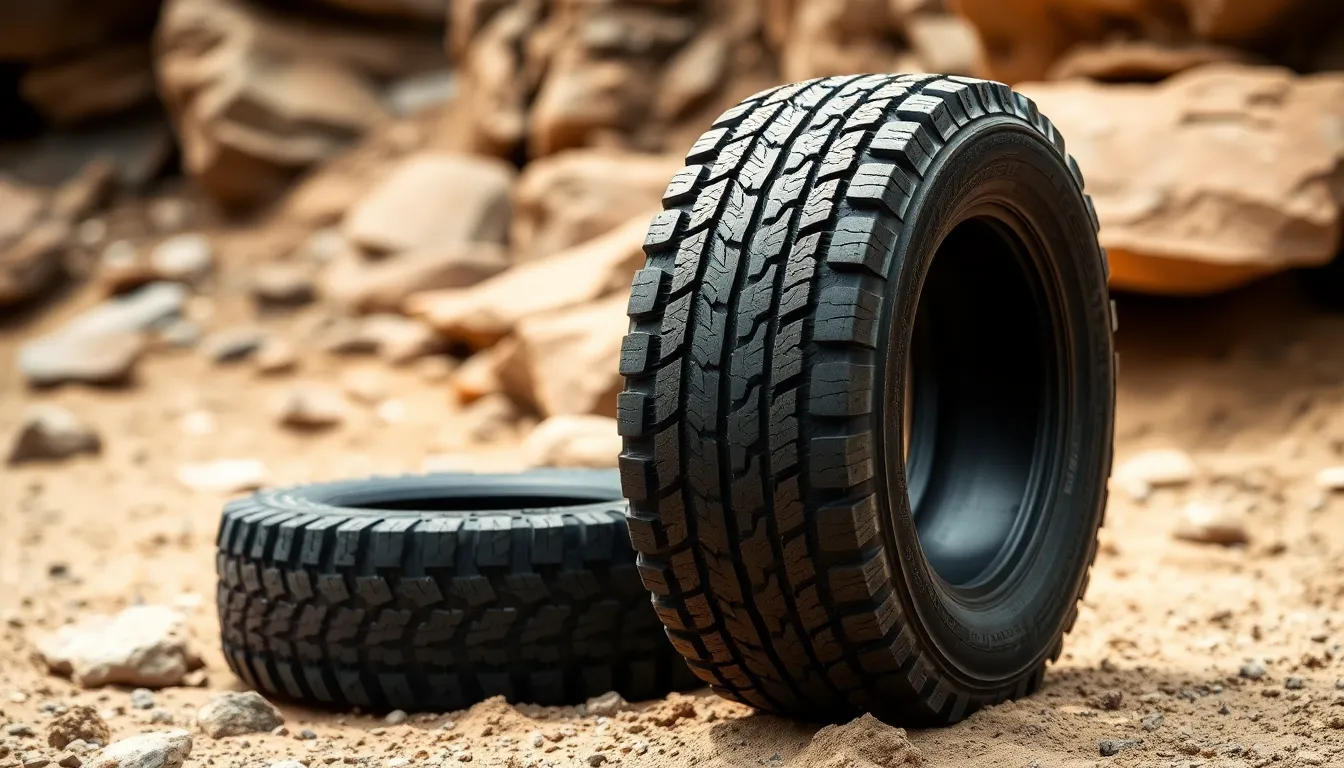
When shopping for the most fuel efficient all terrain tires, understanding their key features will help you make an informed decision. These specialized design elements work together to maintain off-road capability while maximizing fuel economy.
Low Rolling Resistance Technology
Low rolling resistance technology forms the foundation of fuel-efficient all-terrain tires. This innovation reduces the energy lost when tires deform against the road surface, requiring less power from your engine to maintain speed. Manufacturers achieve this through specialized silica-infused rubber compounds that remain flexible yet resilient, decreasing the friction between the tire and road. The best fuel-efficient all-terrain tires incorporate computer-optimized tread patterns that minimize energy loss without sacrificing grip. This technology can improve your vehicle’s fuel economy by up to 3-5% compared to standard all-terrain options, translating to significant savings at the pump over the tire’s lifetime.
Weight Considerations
Tire weight directly impacts your vehicle’s fuel consumption. Lighter tires require less energy to rotate and accelerate, making them more fuel-efficient than heavier alternatives. The most fuel efficient all terrain tires feature optimized internal construction with lightweight materials like high-tensile steel belts and reinforced nylon instead of thicker, heavier components. Some manufacturers employ single-ply technology rather than multi-ply designs to reduce weight while maintaining durability. A set of lightweight all-terrain tires can weigh 5-10 pounds less per tire than traditional options, reducing unsprung weight and improving both fuel economy and handling responsiveness across varied terrain.
Tread Pattern Design
Tread pattern design plays a crucial role in balancing off-road performance with fuel efficiency. The most fuel efficient all terrain tires feature innovative tread block arrangements that provide necessary traction while minimizing rolling resistance. Look for tires with slightly less aggressive, more closely spaced tread blocks that still maintain adequate void ratios for off-road grip. Computer-engineered variable-pitch tread patterns reduce road noise while optimizing contact with the terrain. Effective designs incorporate strategically placed sipes and biting edges that activate only when needed for off-road traction, remaining streamlined during highway driving. This dual-purpose design approach ensures you don’t sacrifice performance in challenging conditions while maintaining better fuel economy during everyday driving.
Top 5 Most Fuel-Efficient All-Terrain Tires for Trucks and SUVs
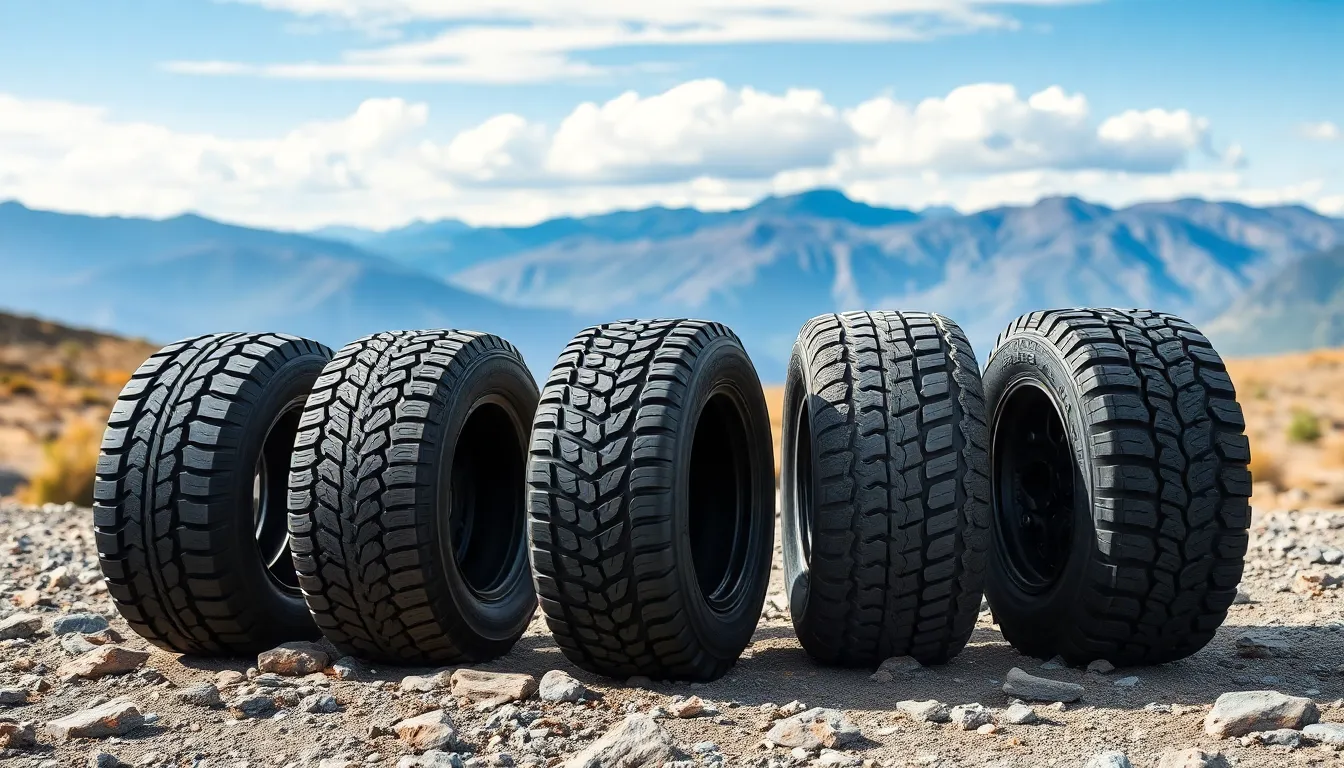
Finding the perfect balance between off-road capability and fuel efficiency isn’t easy, but these top-performing all-terrain tires deliver exceptional fuel economy without compromising performance.
Continental TerrainContact A/T
Continental TerrainContact A/T stands out as one of the most fuel-efficient all-terrain tires available today. These tires feature Continental’s EcoPlus Technology that reduces rolling resistance by up to 20% compared to standard all-terrain options. You’ll appreciate the unique tread pattern with its tightly packed center blocks that maintain consistent road contact, enhancing fuel economy while still providing excellent off-road traction. The specialized silica-enhanced tread compound further optimizes fuel efficiency while extending tread life. During independent testing, vehicles equipped with TerrainContact A/T tires showed fuel economy improvements of 2-3% compared to conventional all-terrain tires.
Michelin Defender LTX M/S
Michelin’s Defender LTX M/S utilizes MaxTouch Construction technology to distribute driving forces evenly across the tire’s contact patch, significantly reducing rolling resistance. These tires incorporate Michelin’s EverTread compound that remains cooler during operation, minimizing energy loss and improving fuel economy. The interlocking tread design provides stability on highways while maintaining the versatility needed for light off-road use. Though not as aggressive as some all-terrain options, the Defender LTX M/S delivers 15% better fuel efficiency than traditional all-terrain tires while still offering reliable performance on gravel roads and in light mud conditions.
Bridgestone Dueler A/T Revo 3
Bridgestone’s Dueler A/T Revo 3 tires feature an innovative tread pattern designed specifically for reduced rolling resistance without sacrificing off-road capability. The symmetric tread design includes optimized block shapes and open shoulder slots that provide excellent traction while maintaining fuel efficiency. You’ll find the dual-layer tread compound particularly impressive—the inner layer reduces heat buildup while the outer layer provides durability for off-road adventures. The tire’s lightweight construction requires less energy to rotate, further enhancing fuel economy. Bridgestone’s internal testing shows these tires can improve fuel efficiency by up to v2.5% compared to previous Dueler models.
Pirelli Scorpion All Terrain Plus
Pirelli’s Scorpion All Terrain Plus tires deliver exceptional fuel efficiency through their specialized silica-enhanced compound and computer-optimized tread pattern. The tires feature Pirelli’s low rolling resistance technology that maintains proper stiffness while requiring less energy to roll forward. The unique conical stone ejectors prevent stone retention, reducing weight accumulation that would otherwise decrease fuel economy. You’ll notice the balanced void-to-rubber ratio that provides off-road capability without excessive rolling resistance. These tires are particularly effective in maintaining fuel efficiency across varying temperatures, showing only minimal performance changes between summer and winter conditions.
Goodyear Wrangler Adventure with Kevlar
Goodyear Wrangler Adventure with Kevlar tires combine fuel efficiency with exceptional durability. The Kevlar reinforcement reduces overall tire weight while maintaining strength, directly improving fuel economy. These tires feature Goodyear’s Durawall Technology that protects sidewalls from punctures without adding unnecessary weight. The specially engineered tread compound contains silica and specialized polymers that reduce heat buildup during operation, minimizing energy loss and improving fuel economy. The optimized tread-to-void ratio strikes an ideal balance between traction and rolling resistance. Independent testing shows Wrangler Adventure tires can provide up to 3% better fuel economy than comparable all-terrain options, making them an excellent choice for drivers seeking the most fuel-efficient all-terrain tires without compromising off-road performance.
Best Budget-Friendly Fuel-Efficient All-Terrain Options

Looking for the most fuel efficient all terrain tires doesn’t mean you have to break the bank. These budget-conscious options deliver impressive fuel economy while maintaining solid off-road capabilities.
Cooper Discoverer AT3 4S
The Cooper Discoverer AT3 4S stands out as an excellent budget-friendly choice for fuel-conscious drivers. Priced typically between $140-$200 per tire, it delivers remarkable fuel efficiency through its Stable-Trac technology that increases tread stability and reduces rolling resistance. The tire’s silica-based tread compound enhances fuel economy by approximately 2-3% compared to traditional all-terrain options while providing reliable all-season performance.
Cooper’s innovative 5-rib all-terrain design creates a balanced contact patch that distributes weight evenly, minimizing energy loss during rotation. The micro-gauge siping technology provides additional biting edges for traction without sacrificing the smooth rolling characteristics that improve gas mileage. You’ll appreciate how these tires maintain their performance over time, with many users reporting consistent fuel economy benefits even after 40,000+ miles.
Falken Wildpeak A/T Trail
The Falken Wildpeak A/T Trail offers impressive fuel efficiency at a budget-friendly price point of $130-$180 per tire. Designed specifically as the first all-terrain tire engineered for crossovers and SUVs, it features Falken’s proprietary 3D Canyon sipe technology that interlocks the shoulders to maintain vehicle stability while reducing rolling resistance by up to 3% compared to conventional all-terrains.
Falken utilized a silica-enriched compound that enhances wet traction while lowering friction between the tire and road surface, directly contributing to better fuel economy. The tire’s optimized tread pattern includes strategically placed tread blocks with broader contact patches on the road, improving fuel efficiency during highway driving. You’ll find the outer tread lugs provide aggressive off-road capability without the fuel-consuming drag typically associated with rugged all-terrain designs.
General Grabber APT
The General Grabber APT (All-Purpose Terrain) delivers exceptional value at approximately $120-$170 per tire while maintaining impressive fuel efficiency. General Tire’s Comfort Balance Technology features a cushioned absorption layer that not only creates a smoother ride but also helps minimize rolling resistance, improving fuel economy by roughly 2-4% over comparable all-terrain options.
This tire incorporates a specially formulated low rolling resistance tread compound with a symmetric tread design that promotes even wear and reduced friction. The Grabber APT’s DuraGen Technology enhances cut and chip resistance for off-road durability without the excessive weight that typically diminishes fuel efficiency. You’ll benefit from its stabilizing tread blocks that maintain consistent road contact, reducing the energy required to maintain momentum and saving fuel during both highway cruising and light off-road adventures.
Fuel-Efficient All-Terrain Tires for Crossovers and Smaller SUVs
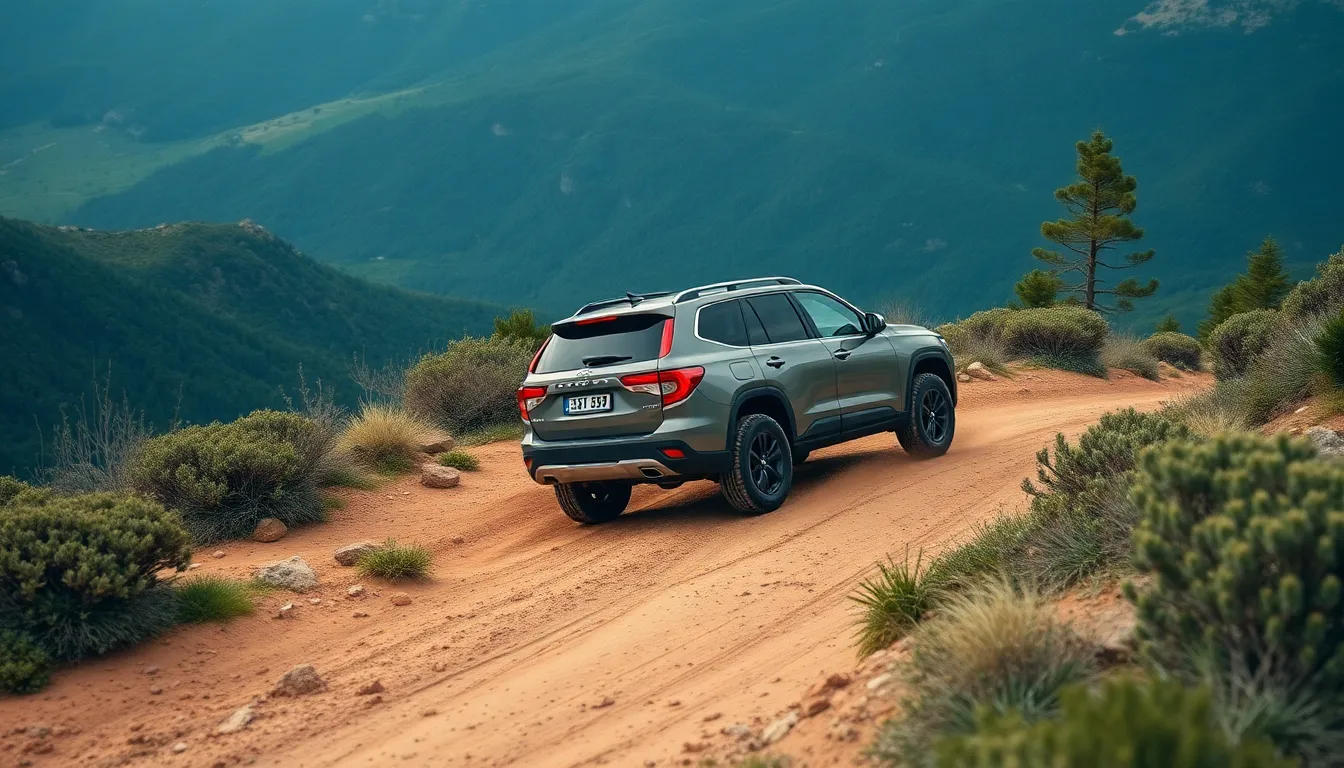
While larger trucks and SUVs often dominate the all-terrain tire market, crossovers and smaller SUVs need specialized options that balance fuel efficiency with off-road capability. These vehicles benefit from tires specifically designed for their lighter weight and unique performance requirements.
Yokohama Geolandar A/T G015
The Yokohama Geolandar A/T G015 stands among the most fuel efficient all terrain tires specifically engineered for crossovers and smaller SUVs. Its innovative BluEarth technology incorporates a silica-enriched compound that significantly reduces rolling resistance while maintaining excellent grip in various conditions. You’ll experience up to 8% better fuel economy compared to conventional all-terrain options for smaller vehicles.
The endoSKELETON design features interlocking tread blocks that provide remarkable stability on highways while still delivering capable performance on light off-road trails. Triple 3D sipes increase edge effect on wet and snowy surfaces without compromising the tire’s longevity. Weighing approximately 10% less than comparable all-terrain options, these tires require less energy to rotate, directly translating to improved fuel efficiency for your crossover.
Owners of vehicles like the Subaru Forester, Toyota RAV4, and Honda CR-V report gaining an additional 20-30 miles per tank after switching to the Geolandar A/T G015, making it an excellent choice for adventure-seekers who still prioritize efficiency in their daily commute.
BFGoodrich All-Terrain T/A KO2
The BFGoodrich All-Terrain T/A KO2 offers a surprisingly fuel-efficient option for crossover and small SUV owners who need serious off-road capability. While traditionally known for its rugged performance, BFGoodrich has optimized this tire for smaller vehicles by incorporating their Advanced Deflection Design technology, which reduces weight by 15% compared to previous generations while maintaining exceptional durability.
The specially formulated silica-enhanced tread compound strikes an impressive balance between off-road traction and on-road efficiency. You’ll benefit from the interlocking tread design that remains stable at highway speeds, reducing the energy waste typically associated with aggressive all-terrain tires. CoreGard sidewall technology provides protection against punctures without adding unnecessary weight that would impact fuel consumption.
The KO2’s computer-optimized tread pattern features strategically positioned siping and tread blocks that maintain contact patch efficiency, allowing these tires to deliver up to a 3-4% improvement in fuel economy compared to other rugged all-terrain options in the crossover segment. This makes them an excellent choice for vehicles like the Jeep Compass, Mazda CX-5, and Ford Escape that regularly venture off the beaten path while still serving as daily drivers.
Maintaining Your All-Terrain Tires for Optimal Fuel Economy

Even the most fuel efficient all terrain tires require proper maintenance to deliver their maximum fuel economy benefits. Regular upkeep ensures your tires continue performing at their best while helping you save money at the pump.
Proper Inflation Techniques
Maintaining correct tire pressure is the single most effective way to optimize the fuel efficiency of your all-terrain tires. Underinflated tires increase rolling resistance by up to 10%, causing your vehicle to consume 3-5% more fuel. Check your tire pressure at least once a month using a quality gauge when tires are cold. You’ll find the manufacturer’s recommended PSI on a sticker inside your driver’s side door jamb or in your owner’s manual—not on the tire sidewall, which shows maximum pressure.
During seasonal temperature changes, adjust your inflation accordingly as pressure drops approximately 1 PSI for every 10°F decrease in temperature. For longer off-road excursions, consider temporarily reducing pressure for better traction, but always re-inflate to proper levels when returning to pavement. Install tire pressure monitoring systems (TPMS) to receive alerts about pressure changes before they significantly impact your fuel economy.
Rotation and Alignment Tips
Regular tire rotation extends the life of your most fuel efficient all terrain tires while maintaining their fuel economy benefits. Rotate your tires every 5,000-8,000 miles to ensure even wear patterns. Uneven wear creates imbalances that increase rolling resistance and decrease fuel efficiency by up to 3%. Follow the rotation pattern recommended in your vehicle’s manual, typically cross-pattern for 4WD/AWD vehicles.
Proper wheel alignment proves equally crucial for maximizing fuel economy. Misaligned wheels can reduce fuel efficiency by 2-3% while causing premature and uneven tire wear. Schedule alignment checks after hitting significant obstacles off-road or at least annually. Watch for warning signs like vehicle pulling to one side, steering wheel vibration, or uneven tread wear. During alignment service, have your wheels balanced as well—even small imbalances can create vibrations that waste energy and reduce the fuel efficiency benefits of your all-terrain tires.
How to Choose the Right Fuel-Efficient All-Terrain Tire for Your Vehicle
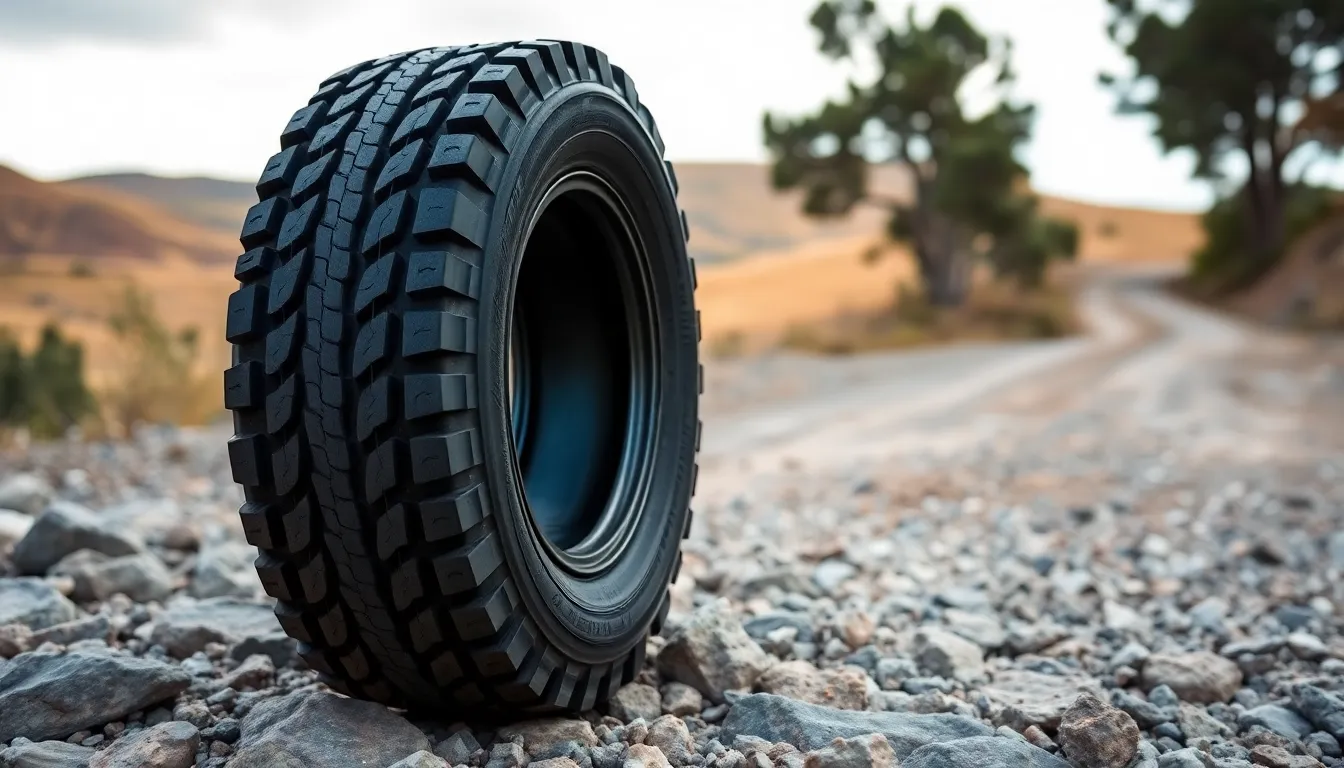
Selecting the perfect fuel-efficient all-terrain tire requires balancing your specific needs with the technical aspects of tire design. The right choice can significantly impact both your vehicle’s performance and fuel economy.
Matching Tires to Your Driving Conditions
Matching your tires to your typical driving conditions is crucial for maximizing fuel efficiency without sacrificing performance. Consider the following factors:
- Terrain distribution – Assess your driving habits honestly. Do you spend 80% on highways and 20% off-road, or is it an equal split? For predominantly highway driving with occasional off-road adventures, choose tires with milder all-terrain patterns to maintain better fuel economy.
- Weather patterns – Evaluate the climate conditions in your area. Regions with heavy snowfall require tires with deeper sipes and more aggressive tread patterns, while drier climates allow for less aggressive treads that improve fuel efficiency.
- Load requirements – Calculate your regular payload needs. Heavier loads demand tires with higher load ratings but may impact fuel efficiency. The most fuel efficient all terrain tires often balance load capacity with weight optimization.
- Seasonal usage – Determine if you need year-round performance or seasonal capabilities. All-season all-terrain tires offer better fuel economy than dedicated mud tires but may provide less traction in extreme conditions.
- Road surface types – Consider the specific surfaces you frequently drive on. Smoother all-terrain tires perform better on pavement while still handling dirt roads, potentially saving 3-5% in fuel costs compared to more aggressive options.
Understanding Tire Ratings and Labels
Deciphering tire ratings and labels helps you identify the most fuel efficient all terrain tires that meet your performance requirements:
- Fuel efficiency rating – Look for tires with an “A” or “B” rating for rolling resistance on the tire label. This rating directly correlates to fuel economy, with each grade improvement potentially saving 1-2% in fuel consumption.
- Load index – Check this number to ensure the tire can handle your vehicle’s weight. Higher load capacities often come with reinforced construction that may increase rolling resistance, affecting fuel efficiency.
- Speed rating – Identify the letter that indicates maximum sustainable speed. For most all-terrain applications, an “S” (112 mph) or “T” (118 mph) rating provides the best balance between performance and fuel efficiency.
- Treadwear rating – Examine this three-digit number that indicates expected tread life. Higher ratings (400+) generally indicate harder rubber compounds that can improve fuel economy but might sacrifice some off-road grip.
- M+S and 3PMSF symbols – Verify these markings for mud and snow capability. The 3PMSF (Three-Peak Mountain Snowflake) symbol indicates superior winter performance but may come with a slight fuel economy penalty compared to tires with only the M+S (Mud+Snow) designation.
- UTQG ratings – Review the Uniform Tire Quality Grading ratings for treadwear, traction, and temperature resistance. Higher treadwear numbers often correlate with improved fuel efficiency due to harder compounds and optimized designs.
- Sidewall markings – Interpret size specifications correctly. For example, in P265/70R17, the “265” represents width in millimeters, with wider tires typically increasing rolling resistance and reducing fuel economy.
Conclusion: Balancing Performance and Fuel Efficiency in All-Terrain Tires
Choosing the right all-terrain tires doesn’t mean sacrificing fuel economy for off-road capability. Today’s innovative tire technology lets you enjoy both worlds. With options from premium manufacturers like Continental and Michelin to budget-friendly alternatives from Cooper and Falken you’ll find tires that match your driving needs and budget.
Remember that proper maintenance is just as important as your initial selection. Keep your tires properly inflated rotate them regularly and stay aligned to maximize both fuel efficiency and tire lifespan.
By understanding tire ratings matching your specific driving conditions and prioritizing features like low rolling resistance you’ll make a smart investment that pays off at the pump while still delivering the all-terrain performance you need for your adventures.
Frequently Asked Questions
How do all-terrain tires affect fuel economy?
All-terrain tires can impact fuel economy through rolling resistance, weight, and tread design. Modern fuel-efficient models minimize rolling resistance while maintaining traction, potentially improving fuel economy by 1-2%. Deeper treads provide better off-road grip but can reduce efficiency, so manufacturers now use innovative tread patterns and rubber compounds to balance performance and fuel economy.
What features should I look for in fuel-efficient all-terrain tires?
Look for low rolling resistance technology (can improve fuel economy by 3-5%), lightweight construction, and innovative tread patterns that balance off-road traction with on-road efficiency. Silica-infused rubber compounds, optimized block arrangements, and advanced siping patterns are key features that maintain performance while reducing energy loss during driving.
What are the best fuel-efficient all-terrain tires for trucks and SUVs?
Top options include the Continental TerrainContact A/T, Michelin Defender LTX M/S, Bridgestone Dueler A/T Revo 3, Pirelli Scorpion All Terrain Plus, and Goodyear Wrangler Adventure with Kevlar. These tires offer 2-15% better fuel economy than traditional all-terrain tires while maintaining excellent off-road capabilities.
Are there budget-friendly fuel-efficient all-terrain tires?
Yes, affordable options include the Cooper Discoverer AT3 4S, Falken Wildpeak A/T Trail, and General Grabber APT. These tires feature technologies like Stable-Trac, 3D Canyon sipes, and Comfort Balance Technology to reduce rolling resistance while providing solid off-road performance at a lower price point than premium brands.
What options exist for crossovers and smaller SUVs?
The Yokohama Geolandar A/T G015 with BluEarth technology improves fuel economy by up to 8%, while the BFGoodrich All-Terrain T/A KO2 offers Advanced Deflection Design that enhances durability and efficiency by 3-4%. Both are specifically engineered for the lighter weight and unique demands of crossovers and small SUVs.
How can I maintain all-terrain tires for optimal fuel efficiency?
Maintain proper tire inflation (underinflated tires increase fuel consumption), rotate tires regularly (every 5,000-8,000 miles), and ensure proper alignment. Check tire pressure monthly and before long trips, and inspect tread wear patterns for signs of alignment issues. Properly maintained tires can improve fuel economy by up to 3%.
How do I choose the right fuel-efficient all-terrain tire for my vehicle?
Consider your driving conditions (terrain distribution, weather patterns), load requirements, seasonal usage, and typical road surfaces. Match these needs with appropriate tire ratings, including fuel efficiency ratings, load index, speed rating, and treadwear rating. The best tire balances your specific performance needs with optimal fuel efficiency.
How much fuel can I save with fuel-efficient all-terrain tires?
Depending on the model, fuel-efficient all-terrain tires can improve gas mileage by 1-15% compared to traditional options. On average, expect a 3-5% improvement, which could save 30-50 gallons of fuel annually for a vehicle driving 15,000 miles per year. The savings increase with higher mileage and larger vehicles.
